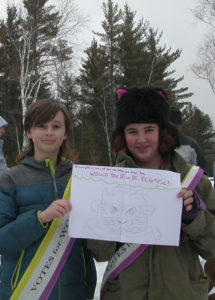
What do we want? Something or other.
When do we want it? Sometime.
The morning of the Women’s March I walked out to my car and discovered my rear driver’s side tire was low. Not flat, but low enough that I had to drive miles out of my way to a convenience store to get air. I had planned to get to the March a bit early, but now I only hoped the tire would hold for the thirty mile drive.
Miraculously, I arrived on time. The tire had lost air, but it held well enough to get me to Lewis, New York, for the march and rally at the gravesite of suffragist Inez Milholland (see last week’s post). I was stunned at the turnout. Over three hundred people were there, mostly women but plenty of men and children too, many wearing pussyhats and carrying great signs. Three hundred sounds like a small number in a protest of millions, and I guess it is, but Lewis is a hamlet in a very rural county — a county that voted for Trump by three percentage points. The signs reflected concerns across the country about reproductive rights, diversity, racial justice, and sexual harrassment.
I thought the March was great right up to the point where the speaking started, and then I wondered why I bothered to come. The leader of the Lewis March spoke about the history of the suffrage movement, offering some quotes from Milholland. So far, so good. Then she spoke about how we had gathered for “truth.” That was all: not even a passing reference to actual struggles of women today, where we need to go, and how we get there. I guess being on the side of truth is a political statement in this post-truth era, but truth about what? There was no focus to this march. All the energy was dissipated on non-offensive, non-directed pablum, and the whole thing became a celebration of tribal identity, not a demand for women’s rights.
In some ways, the well-attended Lewis non-event was a microcosm of issues that spilled out with the national March during the lead-up period. Many women were unclear about the purpose of the March. Organizers expressed a commitment to inclusivity, but that did not appear to include a feminist perspective. For example, organizers headlined a self-admitted rapist and a champion of “sex work,” angering sex industry survivors. The organizers declared this was not a protest any kind and not specifically about women. Despite the timing of the event the day after the inauguration, they insisted this march was not intended to be anti-Trump. So what was this about?
News media defined the March entirely as anti-Trump, sometimes even omitting to say that it was a women’s march. To be fair, most people I talked to were motivated primarily by their horror of Trump, and the demonstrators’ signs bore this out. The pink pussyhats were everywhere (even in Lewis). I have to admit that I originally thought the pussyhats were a bit silly. I didn’t say anything because I was happy to see women excited about a project and pouring their creativity into something, but privately I thought it was dumb. I changed my mind when I saw the pussyhats in action, sending a message that so many women and men who showed up to the March thought sexual harassment and assault worthy of protest at this thing that was not supposed to be a protest. And the signs! So many uteruses, vulvas, and vaginas. They showed that women rightly see their oppression as intricately tied to their biology, and the innocence with which this was displayed showed that apparently many have not gotten the memo that references to female anatomy are oppressive to trans people and must be exorcised from all women’s gatherings. I suspect that when most women have gotten that memo, there will be a huge rebellion, and many things about gender that have been accepted without question will be scrutinized.

But that rebellion is years away, and I believe that for now the women’s movement is in a long period of struggle to accept and confront the problem. Our problem is not violence; it is male violence directed at women. Our problem is not gender; it is the use of gender by males to define, redefine, and undefine women. Our problem is not sexual harassment; it is the sexual harassment by males toward females (and children). Our problem is not religion; it is male religions dictating to women what we can and cannot do. Our problem is men, and until a critical mass of women can name the agent of our oppression, I do not see the women’s movement progressing, no matter how many show up for a non-directed protest.
There was an indoor follow-up event ten miles away from the Lewis rally, and I had planned on attending it, but after the rather demoralizing graveside experience I decided to get my tire fixed. I think that the March was a success in that it sent a message to our Democratic lawmakers that large numbers of women all over the country and all over the world are paying attention to Republican efforts to erode human rights, and that these lawmakers need to stand up to Trump. That alone was worth the small investment of showing up. As far as the march for women’s liberty goes — we have a long road in front of us.

